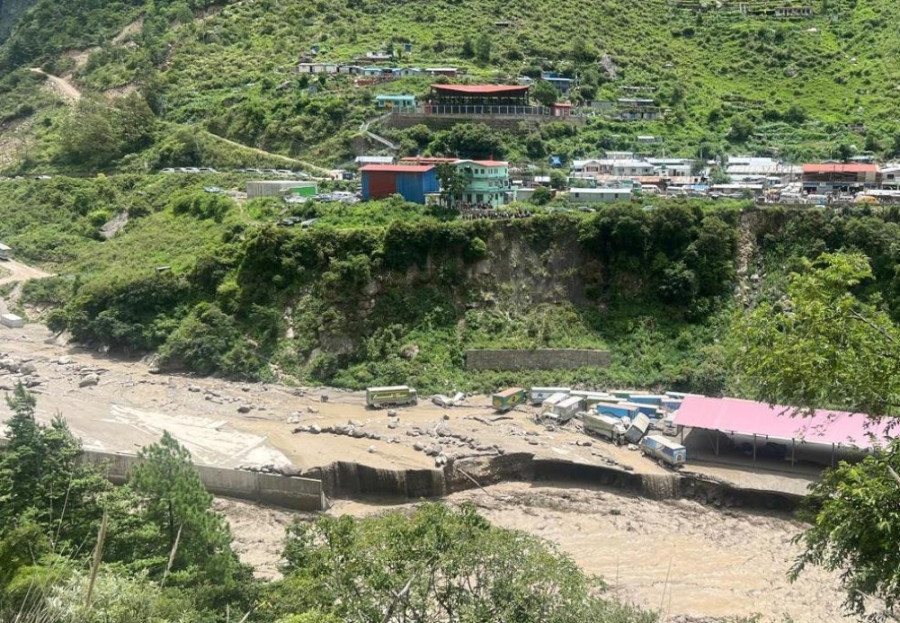Wed, Jan 7, 2026
Editorial
Late learning
How many settlements must be swept away, and how many must die before we take climate risks seriously?
bookmark
Published at : August 7, 2025
Updated at : August 8, 2025 08:07
Last month’s flash flood in Tibet’s Lhende River resulted in unfathomable destruction downstream, particularly in Nepal’s Rasuwa district. Besides killing nine people, it swept away the Miteri bridge, a vital trade route along the Nepal-China border, as well as loaded trucks and vehicles. It also ravaged an under-construction container depot inland, the barrage of the 111-megawatt Rasuwagadhi Hydropower Project and several other hydropower projects. That is not all. It cut off the entire section of the Rasuwagadhi-Timure area and also disrupted electricity, telephone and internet services. Even in 2024, as per preliminary estimates, Nepal lost $32 billion due to unprecedented rainfall during the monsoon.
Such extreme events are becoming increasingly common in this Himalayan country that is highly vulnerable to climate change. When there are natural disasters, our existing infrastructures, built on historical risk assessments, often fail. But there is still no thoughtful plan to rebuild or to develop climate-resilient infrastructure. Nor are proper infrastructure risk assessments carried out. Houses are rebuilt on sites previously swept by floods and landslides. For instance, even as experts have deemed the Seti River in Kaski district a “permanent danger” to settlements in select wards of Pokhara Metropolitan City and Annapurna and Machhapuchhre Rural Municipalities following the 2012 flash flood tragedy, houses are already sprouting up. No actions have been taken to prevent this. A similar trend is seen in several other river banks around the country. Concomitantly, our existing early warning systems have not been working properly. Nepal is thus unprepared for future climate extremes.
How many settlements, bridges and roads must be swept away, and how many people must die from climate-induced disasters before we start taking these risks seriously? Climate scientists, experts and geologists have repeatedly emphasised the need for climate-resilient infrastructures in Nepal. A recent Associated Press report, highlighting the same, notes an analysis from the Coalition for Disaster Resilient Infrastructure, an international partnership of governments and other agencies working to promote climate-resilient infrastructures. It warns that Nepal’s infrastructure, worth $124 billion, is prone to the impacts of climate-driven disasters, and if the country doesn’t prioritise resilient infrastructure, the country could face annual losses amounting to hundreds of millions of dollars.
Even small steps towards infrastructure resilience could save the country from significant losses. Such extreme disasters throughout South Asia, and the most recent mayhem in Dharali, Uttarakhand, India, highlights the need for regional collaboration and commitments in building climate-resilient infrastructures. Moreover, it is vital to develop climate modelling to identify at-risk areas, build flexible and adaptive infrastructure, in addition to investing in early warning systems and promoting reforestation and watershed management. Another priority should be strictly prohibiting people from settling down on river banks previously swamped by floods and landslides.
In May, Nepal initiated a much-anticipated global dialogue on climate change and sustainable development under the theme “Climate Change, Mountains and the Future of Humanity”. But the event host is apparently yet to internalise the message it wants to send out to the rest of the world. Only climate-resilient infrastructure can save lives and put the country on the path of sustainable development.
Most Read from Editorial
Editor's Picks
E-PAPER | January 07, 2026
×




 6.84°C Kathmandu
6.84°C Kathmandu














